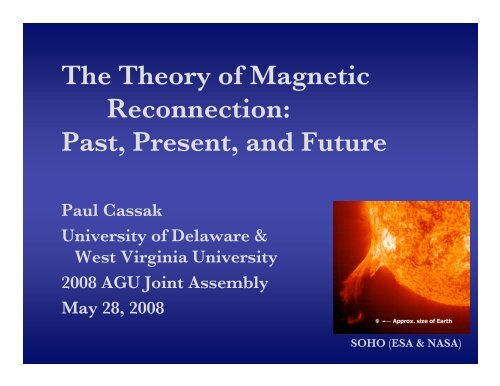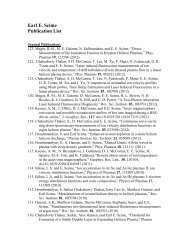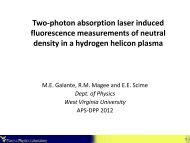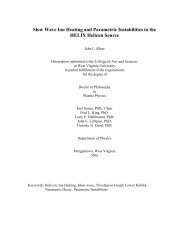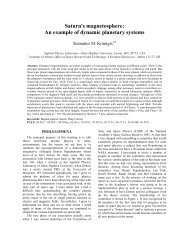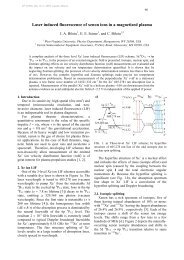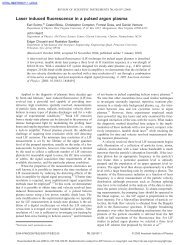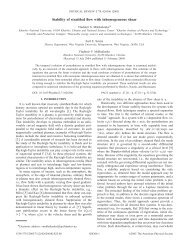The Theory of Magnetic Reconnection - Plasma Physics at West ...
The Theory of Magnetic Reconnection - Plasma Physics at West ...
The Theory of Magnetic Reconnection - Plasma Physics at West ...
You also want an ePaper? Increase the reach of your titles
YUMPU automatically turns print PDFs into web optimized ePapers that Google loves.
<strong>The</strong> <strong>The</strong>ory <strong>of</strong> <strong>Magnetic</strong><br />
<strong>Reconnection</strong>:<br />
Past, Present, and Future<br />
Paul Cassak<br />
University <strong>of</strong> Delaware &<br />
<strong>West</strong> Virginia University<br />
2008 AGU Joint Assembly<br />
May 28, 2008<br />
SOHO (ESA & NASA)
<strong>Magnetic</strong> <strong>Reconnection</strong><br />
• An ISI search by topic found >5,500 papers from 1957-2007 on reconnection<br />
500<br />
<strong>Reconnection</strong> Public<strong>at</strong>ions<br />
10,000<br />
<strong>Reconnection</strong> Cit<strong>at</strong>ions<br />
250<br />
5,000<br />
1957<br />
1975<br />
1991<br />
2007<br />
1957<br />
1975<br />
1991<br />
2008<br />
• Focus <strong>of</strong> this talk: the fundamental theory <strong>of</strong> reconnection<br />
• To be omitted: observ<strong>at</strong>ions, experiments, applic<strong>at</strong>ions<br />
(except where relevant)
Outline<br />
• “Considerable astrophysical importance”<br />
– <strong>The</strong> Early History <strong>of</strong> <strong>Magnetic</strong> <strong>Reconnection</strong><br />
• “Other altern<strong>at</strong>ives”<br />
– A Recent History <strong>of</strong> <strong>Magnetic</strong> <strong>Reconnection</strong><br />
• <strong>The</strong> Devil is in the Details<br />
– <strong>The</strong> Present and the Future
Pre 1930s Solar Astronomy<br />
• Solar flare history<br />
– Discovered (no l<strong>at</strong>er than) 1859<br />
(Carrington, MNRAS, 1859;<br />
Hodgson, MNRAS, 1859)<br />
– First pictures <strong>of</strong> a flare taken<br />
(Hale, Astron. Astrophys., 1892)<br />
• History <strong>of</strong> solar dynamics<br />
– Vortical flow discovered around<br />
sunspots (Hale, Ap. J., 1908a), likened<br />
to cyclones and tornados on Earth<br />
– <strong>Magnetic</strong> fields detected in sunspots<br />
(Hale, Ap. J., 1908b)<br />
Carrington, 1859<br />
– MHD yet to be discovered (Alfvén, N<strong>at</strong>ure, 1942)<br />
• Sun described by hydrodynamics,<br />
not electromagnetism or hydromagnetics<br />
G. E. Hale
Ronald Giovanelli<br />
• Observ<strong>at</strong>ional study <strong>of</strong> flares (Giovanelli, Ap. J., 1939):<br />
– “[M]ost eruptions can be associ<strong>at</strong>ed<br />
with particular spot groups.”<br />
• New theory <strong>of</strong> flares (Giovanelli, MNRAS, 1947):<br />
– <strong>The</strong> magnetic field due to a sunspot cancels<br />
the dipole field <strong>at</strong> a “neutral point.”<br />
– Electric fields near neutral points can<br />
acceler<strong>at</strong>e particles and drive currents.<br />
“<strong>The</strong> localiz<strong>at</strong>ion <strong>of</strong> these phenomena in the<br />
neighbourhood <strong>of</strong> sunspots suggests a basis<br />
<strong>of</strong> an explan<strong>at</strong>ion <strong>of</strong> solar flares.”<br />
– This theory <strong>of</strong> flares is electromagnetic,<br />
not hydrodynamic!<br />
Giovanelli, 1947
James Dungey<br />
• Giovanelli discussed his model with Fred Hoyle<br />
– He became interested in it both for flares and auroral<br />
applic<strong>at</strong>ions (Hoyle, Some Recent Researches in Solar <strong>Physics</strong>, 1949)<br />
• Hoyle gave the problem to his grad student, Dungey, in 1947<br />
– A non-zero resistivity η allows the topology <strong>of</strong> the magnetic<br />
field to change near a neutral point (Dungey, Phil. Mag., 1953)<br />
– Suggested the same effect occurs in the magnetosphere,<br />
coined the phrase “magnetic reconnection” (Dungey, 1950s)<br />
Dungey, 1958<br />
Dungey, 1961
Peter Sweet<br />
• Gave a solar flare model using<br />
Giovanelli/Dungey mechanism<br />
– Two bipolar regions come together.<br />
– <strong>The</strong> field fl<strong>at</strong>tens “analogous to the<br />
fl<strong>at</strong>tening <strong>of</strong> a motor tyre when loaded.”<br />
– “A thin collision layer <strong>of</strong> gas is formed”<br />
<strong>at</strong> the neutral point.<br />
– Used hydrodynamic analogy <strong>of</strong> pl<strong>at</strong>es<br />
forced together with a fluid in between.<br />
• Presented <strong>at</strong> Intern<strong>at</strong>ional Astronomical<br />
Union Symposium No. 6 (Electromagnetic<br />
Phenomena in Cosmical <strong>Physics</strong>),<br />
Stockholm, Sweden, August 27-31, 1956.<br />
Proceedings published in 1958.<br />
Sweet, 1958
Eugene Parker<br />
• Parker was <strong>at</strong> the meeting to present<br />
“On the Vari<strong>at</strong>ions <strong>of</strong> Cosmic Ray Intensity”<br />
• Came up with his solution on<br />
the way back to the United St<strong>at</strong>es
Sweet-Parker Scaling<br />
• A steady-st<strong>at</strong>e is reached when field lines<br />
convect into the collisional layer <strong>at</strong><br />
the same r<strong>at</strong>e th<strong>at</strong> they are annihil<strong>at</strong>ed<br />
v in<br />
~ !c 2<br />
4!"<br />
• “<strong>The</strong> pressure available for squeezing<br />
the fluid out …” is magnetic (B 2 /8π), so<br />
“from energy consider<strong>at</strong>ions,” the outflow speed is<br />
• Combine with continuity “based<br />
on geometrical consider<strong>at</strong>ions,” v in<br />
~ ! L v out<br />
δ<br />
v in<br />
v out<br />
~<br />
B x<br />
L<br />
B x<br />
4!! ~ c A<br />
v out<br />
• <strong>The</strong> result (Parker, JGR, 1957)<br />
!<br />
L ~ v in<br />
cE<br />
~ ~<br />
v out<br />
B x<br />
c A<br />
"c 2<br />
4!c A<br />
L ~ S-1/2<br />
– It is fully nonlinear and (almost) entirely self-consistent<br />
• Based on conserv<strong>at</strong>ion laws (mass, energy, magnetic flux)<br />
– It has been confirmed by simul<strong>at</strong>ions (Biskamp, Phys. Fluids, 1986)<br />
and experiments (Ji et al., PRL, 1998) in certain regimes
<strong>The</strong> Sweet-Parker Model<br />
• Drawbacks<br />
– L is a free parameter which scales<br />
with the system size (for the corona,<br />
L ~ radius <strong>of</strong> a flux tube ~ 10 4 km)<br />
δ<br />
v in<br />
B x<br />
v out<br />
– <strong>The</strong> model is MUCH too slow to explain<br />
the observed energy release r<strong>at</strong>es in flares<br />
L<br />
– Can Sweet-Parker reconnection be made faster? (Parker, Ap. J. Supp. Ser., 1963)<br />
• Considered runaway electrons and ambipolar diffusion, concluding it wouldn’t work.<br />
• Need a new mechanism which decreases L or anomalously increases η<br />
“<strong>The</strong> observ<strong>at</strong>ional and theoretical difficulties with the<br />
hypothesis <strong>of</strong> magnetic-field line annihil<strong>at</strong>ion suggest<br />
th<strong>at</strong> other altern<strong>at</strong>ives for the flare must be explored.”<br />
(Parker, Ap. J. Supp. Ser., 1963)
Outline<br />
• “Considerable astrophysical importance”<br />
– <strong>The</strong> Early History <strong>of</strong> <strong>Magnetic</strong> <strong>Reconnection</strong><br />
• “Other altern<strong>at</strong>ives”<br />
– A Recent History <strong>of</strong> <strong>Magnetic</strong> <strong>Reconnection</strong><br />
• <strong>The</strong> Devil is in the Details<br />
– <strong>The</strong> Present and the Future
Harry Petschek<br />
• Gave a talk <strong>at</strong> AAS-NASA Symposium, <strong>Physics</strong> <strong>of</strong><br />
Solar Flares, Greenbelt, Maryland, October 28-30, 1963.<br />
– “[P]revious analyses overlooked standing<br />
magneto-hydrodynamic waves as a possible mechanism<br />
for converting magnetic energy to plasma energy.”<br />
– Waves become switch-<strong>of</strong>f (slow) shocks if compressible<br />
– <strong>Reconnection</strong> r<strong>at</strong>e fast enough to explain solar flares<br />
Open<br />
outflow<br />
region<br />
Small Sweet-Parker region<br />
Petschek, 1964<br />
Standing waves<br />
drive outflow<br />
• Quote from Peter Sweet in the discussion period:<br />
“I am in favor <strong>of</strong> your theory, which I thoroughly approve. Dr. Parker and I have<br />
been living with this problem for several years and have got the feel <strong>of</strong> it. Your<br />
solution struck me <strong>at</strong> once as the solution for which we have been seeking.”<br />
• However, the theory is not self-consistent! It occurs for localized η (S<strong>at</strong>o and<br />
Hayashi, Phys. Fluids, 1979), but not for uniform η (Biskamp, Phys. Fluids, 1986)
<strong>The</strong> Hall Effect<br />
• <strong>The</strong> Hall effect enters through the generalized Ohm’s law<br />
(Vasyliunas, Rev. Geophys. Space Phys., 1975):<br />
r<br />
E +<br />
r<br />
v i<br />
! r B<br />
c<br />
Convection<br />
= " r J +<br />
Resistivity<br />
1<br />
nec<br />
r<br />
J ! r B -<br />
Hall<br />
effect<br />
1<br />
ne<br />
r<br />
# $ t p e<br />
-<br />
Electron<br />
pressure<br />
m e<br />
e<br />
dv r e<br />
dt<br />
Electron<br />
inertia<br />
– <strong>The</strong> Hall effect alone does not allow for reconnection;<br />
dissip<strong>at</strong>ion is necessary for the field lines to break.<br />
• <strong>The</strong> Hall effect alters the structure <strong>at</strong> and below<br />
ion gyro-scales (Sonnerup, 1979).<br />
• Help from the fusion community:<br />
– <strong>Reconnection</strong> is much faster than Sweet-Parker <strong>at</strong> length<br />
scales below the ion gyro-radius (Aydemir, Phys. Fluids B, 1992).<br />
Sonnerup, 1979
Hall <strong>Reconnection</strong><br />
• Why is Hall reconnection fast?<br />
– Hall effect makes Alfvén waves dispersive (whistlers) (Dungey, 1954)<br />
– Since whistlers are dispersive (ω ~ k 2 ), the waves driving the outflow<br />
are faster <strong>at</strong> smaller scales (Mandt et al., GRL, 1994).<br />
v out<br />
~ ! k ~ k ~ 1 "<br />
so the reconnection r<strong>at</strong>e is independent <strong>of</strong> dissip<strong>at</strong>ion mechanism<br />
– <strong>Reconnection</strong> is fast provided the outflow is driven by dispersive waves<br />
(Rogers et al., PRL, 2001)<br />
Non-dispersive<br />
waves<br />
Dispersive<br />
waves<br />
adapted from Drake and Shay, 2007
Hall <strong>Reconnection</strong><br />
• Hall effect (plus dissip<strong>at</strong>ion) gives fast<br />
reconnection with the Petschek shock structure<br />
– Hall reconnection r<strong>at</strong>e is fast enough to explain<br />
energy release r<strong>at</strong>e in flares/substorms<br />
(Shay et al., GRL, 1999)<br />
– GEM Challenge (Birn et al., JGR, 2001):<br />
Same simul<strong>at</strong>ion run with multiple codes;<br />
Hall effect sufficient to make reconnection fast<br />
– Sign<strong>at</strong>ures <strong>of</strong> Hall reconnection observed<br />
in the magnetosphere (Nagai et al., JGR, 2001;<br />
Deng and M<strong>at</strong>sumoto, N<strong>at</strong>ure, 2001; Oieroset et al.,<br />
N<strong>at</strong>ure, 2001; Mozer et al., PRL, 2002) and in<br />
labor<strong>at</strong>ory experiments (Cothran et al., GRL, 2005;<br />
Ren et al., PRL, 2005; Frank et al., Phys. Lett. A, 2006)<br />
Courtesy <strong>of</strong> M. Shay<br />
Birn et al., 2001<br />
Hall model is (almost) entirely self-consistent<br />
model <strong>of</strong> fast reconnection,<br />
though aspects remain under study.
Outline<br />
• “Considerable astrophysical importance”<br />
– <strong>The</strong> Early History <strong>of</strong> <strong>Magnetic</strong> <strong>Reconnection</strong><br />
• “Other altern<strong>at</strong>ives”<br />
– A Recent History <strong>of</strong> <strong>Magnetic</strong> <strong>Reconnection</strong><br />
• <strong>The</strong> Devil is in the Details<br />
– <strong>The</strong> Present and the Future<br />
• Is the Hall Effect Enough?<br />
• <strong>Reconnection</strong> Onset and Energy Storage<br />
• <strong>The</strong> Role <strong>of</strong> <strong>Reconnection</strong> in Particle Acceler<strong>at</strong>ion<br />
• Asymmetric <strong>Magnetic</strong> <strong>Reconnection</strong><br />
• Additional Topics in <strong>Magnetic</strong> <strong>Reconnection</strong> <strong>The</strong>ory
Is the Hall Effect Enough?<br />
• Open questions<br />
– Wh<strong>at</strong> maintains a small L?<br />
• Secondary island form<strong>at</strong>ion (Daughton et al., Phys. <strong>Plasma</strong>s, 2006)<br />
• <strong>The</strong> Hall effect (Drake et al., Phys. <strong>Plasma</strong>s, 2008)<br />
– Wh<strong>at</strong> is the role <strong>of</strong> the Hall effect?<br />
• Contrast with “electron-positron” reconnection in which Hall effect vanishes<br />
(Bessho and Bh<strong>at</strong>tacharjee, PRL, 2005; Hesse and Zenitani, Phys. <strong>Plasma</strong>s, 2007;<br />
Daughton and Karimabadi, Phys. <strong>Plasma</strong>s, 2007; Swisdak et al., Ap. J., 2008;<br />
Zenitani and Hesse, Phys. <strong>Plasma</strong>s, 2008)<br />
– Wh<strong>at</strong> is the dissip<strong>at</strong>ion mechanism?<br />
• Non-gyrotropic electron pressure (Hesse et al., Phys. <strong>Plasma</strong>s, 1999 & 2004; Pritchett,<br />
JGR, 2001 & Phys. <strong>Plasma</strong>s, 2005; Ricci et al., GRL, 2002 & Phys. <strong>Plasma</strong>s, 2004)<br />
• Mixing between incoming and outgoing particles gives effective diffusion <strong>at</strong><br />
electron Larmor radius scales (Hesse, Phys. <strong>Plasma</strong>s, 2006)<br />
• Recent discovery - New results about the electron dissip<strong>at</strong>ion region<br />
– Much longer than previously thought<br />
(Daughton et al., Phys. <strong>Plasma</strong>s, 2006;<br />
Fujimoto, Phys. <strong>Plasma</strong>s, 2006).<br />
– Has a two-scale structure (Shay et al.,<br />
PRL, 2007; Karimabadi et al., GRL, 2007)<br />
• Observed in magnetosphere, >60 ion<br />
inertial scales (Phan et al., PRL, 2007)<br />
Shay et al., 2007
• Open question<br />
Particle Acceler<strong>at</strong>ion<br />
– Giovanelli’s model cannot explain observ<strong>at</strong>ions because only few<br />
electrons would acceler<strong>at</strong>e (the “numbers problem”). Is the acceler<strong>at</strong>ion<br />
caused by the physics <strong>of</strong> reconnection or a secondary mechanism?<br />
• Recent models -<br />
– Collision <strong>of</strong> outflow jet with plasma in island (Hoshino et al., JGR, 2001)<br />
– Parallel electric fields in density cavities (Drake et al., PRL, 2005; Pritchett, JGR, 2006).<br />
– Contracting magnetic islands<br />
• As newly formed islands contract, electrons<br />
feel a kick <strong>at</strong> the end <strong>of</strong> the island<br />
(Fermi mechanism) (Drake et al., N<strong>at</strong>ure, 2006)<br />
• All electrons particip<strong>at</strong>e, and electrons<br />
jumping to multiple islands<br />
potentially solves the numbers problem.<br />
• Magnetotail observ<strong>at</strong>ions found a correl<strong>at</strong>ion<br />
between acceler<strong>at</strong>ed electrons and magnetic<br />
islands (Chen et al., N<strong>at</strong>ure Phys., 2008)<br />
Drake et al., N<strong>at</strong>ure, 2006
Onset and Energy Storage<br />
• Open questions -<br />
– Why does fast reconnection initi<strong>at</strong>e suddenly?<br />
• Onset <strong>of</strong> localized anomalous resistivity (example - LHDI threshhold is v ed<br />
> v th,i<br />
)<br />
• Secondary (ideal) instability <strong>of</strong> Sweet-Parker current layer (Dahlburg et al., Ap. J., 2005)<br />
• After (Aydemir, Phys. Fluids B, 1992), it was suggested th<strong>at</strong> the rapid growth<br />
<strong>of</strong> Hall reconnection could explain onset (Wang and Bh<strong>at</strong>tacharjee, PRL, 1993).<br />
– Wh<strong>at</strong> prevents fast reconnection before a flare (allowing energy to be stored)?<br />
• Recent discovery - <strong>Reconnection</strong> is bistable (Cassak et al., PRL, 2005 & 2007)<br />
– Both Sweet-Parker and Hall are accessible for given<br />
parameters; the system is history dependent<br />
• Sweet-Parker domin<strong>at</strong>es until length scales are<br />
comparable to gyro-scales, onset <strong>of</strong> Hall is c<strong>at</strong>astrophic<br />
• Evidence for this in labor<strong>at</strong>ory plasmas<br />
(Ren et al., PRL, 2005; Egedal et al., PRL, 2007)<br />
• Observ<strong>at</strong>ional d<strong>at</strong>a from stellar flares consistent<br />
with this condition (Cassak et al., Ap. J. Lett., 2008)<br />
– Two conclusions - Hall effect is important in corona and<br />
Sweet-Parker explains energy storage before an eruption<br />
Cassak et al., 2008
Asymmetric <strong>Reconnection</strong><br />
• Open questions<br />
– How does reconnection proceed in asymmetric conditions<br />
(with dispar<strong>at</strong>e plasmas on either side <strong>of</strong> the dissip<strong>at</strong>ion region)?<br />
• Recent discovery - <strong>The</strong> Sweet-Parker analysis extended to<br />
asymmetric systems (Cassak and Shay, Phys. <strong>Plasma</strong>s, 2007)<br />
– Based on conserv<strong>at</strong>ion laws:<br />
(! 1<br />
v 1<br />
+ ! 2<br />
v 2 ) L ~ (! out<br />
v out )2"<br />
2<br />
B 1<br />
8# v + B 2<br />
$<br />
2<br />
1<br />
8# v ' $<br />
&<br />
2) L ~ 1<br />
%<br />
( 2 ! v '<br />
2<br />
out out<br />
%<br />
&<br />
(<br />
) v 2" out<br />
v 1<br />
B 1<br />
~ v 2<br />
B 2<br />
2<br />
v out<br />
~ B 1 B 2<br />
4!<br />
B 1<br />
+ B 2<br />
" 1<br />
B 2<br />
+ " 2<br />
B 1<br />
E ~ 1 # B 1<br />
B 2<br />
&<br />
c<br />
%<br />
$ B 1<br />
+ B<br />
(<br />
2 '<br />
v 2)<br />
out<br />
L<br />
– Various parameter regimes have been simul<strong>at</strong>ed (Borovsky and Hesse,<br />
Phys. <strong>Plasma</strong>s, 2007; Birn et al., Phys. <strong>Plasma</strong>s, 2008; Pritchett, JGR, 2008)<br />
– <strong>The</strong>ory agrees with global MHD simul<strong>at</strong>ions (Borovsky et al., JGR, 2008)<br />
– A first principles solar wind-magnetospheric coupling model gave as good<br />
predictive capability as the previous best model (Borovsky, JGR, 2008)
More Open Questions<br />
• Is the fast reconnection r<strong>at</strong>e always 0.1? Why?<br />
• Can reconnection be steady in time or is it fundamentally bursty?<br />
• How do multiple microscopic reconnection events organize<br />
into macroscopic events (like flares and substorms)?<br />
• Wh<strong>at</strong> is the n<strong>at</strong>ure <strong>of</strong> reconnection in three-dimensions?<br />
– Hornig and Priest, Phys. <strong>Plasma</strong>s, 2003; Pontin and Galsgaard, JGR, 2007; Pontin<br />
and Craig, Ap. J., 2006; Haynes et al., Proc. Roy. Soc. A, 2007; Longcope et al., Ap.<br />
J., 2001 & 2005; Linton et al., Ap. J., 2001; Linton and Priest, Ap. J., 2003; Dorelli et<br />
al., JGR, 2007; Dorelli and Bh<strong>at</strong>tacharjee, Phys. <strong>Plasma</strong>s, 2008; Lapenta et al., Phys.<br />
<strong>Plasma</strong>s, 2003; Scholer et al., Phys. <strong>Plasma</strong>s, 2003; Huba and Rudakov et al., Phys.<br />
<strong>Plasma</strong>s, 2002; Shay et al., GRL, 2003; Yin et al., PRL, submitted; …<br />
• Does turbulence make reconnection faster? (M<strong>at</strong>thaeus and Lamkin,<br />
Phys. Fluids, 1986; Lazarian and Vishniac, Ap. J., 1999; Smith et al., GRL,<br />
2004).<br />
• Applic<strong>at</strong>ions <strong>of</strong> <strong>Reconnection</strong><br />
– Solar corona (eruptions and he<strong>at</strong>ing) and chromosphere, magnetosphere,<br />
astrophysical settings, labor<strong>at</strong>ory experiments, fusion devices, …
Conclusion<br />
• “So the physics <strong>of</strong> rapid reconnection has come a long way in the<br />
half-century since it was first proposed.” (Parker, Convers<strong>at</strong>ions on Electric<br />
and <strong>Magnetic</strong> Fields in the Cosmos, 2007)<br />
• Contributors to magnetic<br />
reconnection theory:<br />
– solar observers, plasma theorists,<br />
solar theorists,<br />
aeronautical engineers,<br />
fusion experimentalists,<br />
fusion theorists,<br />
magnetospheric observers,<br />
astrophysicists,<br />
reconnection numericists<br />
and experimentalists<br />
• Much more to be learned<br />
about reconnection!<br />
• Thank you!<br />
– Thanks to Bill Daughton, Jim Drake,<br />
Jim Klimchuk, Dermott Mullan, Michael Shay, Julie Bryan<br />
http://www.msfc.nasa.gov/


